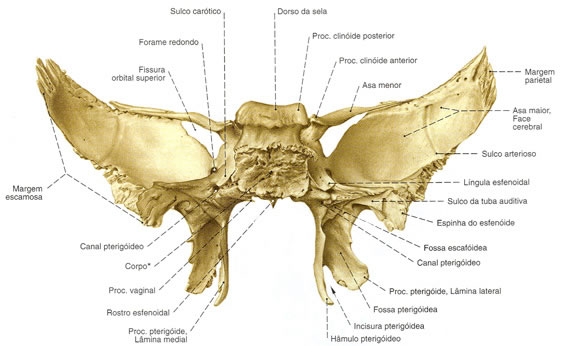Sphenoid bone
It is an irregular, unpaired bone and is located at the base of the skull anterior to the temporals and the basilar portion of the occipital bone.
The sphenoid bone is divided into:
- body (1)
- Lesser Wings (2)
- Greater Wings (2)
- Pterygoid Processes (2).
Body
a) Top face:
- pituitary fossa
- Middle and Posterior Clinoid Processes
- Ethmoid Spine – articulates with the cribriform plate of the ethmoid bone
- Sella Turcica – houses the pituitary
- Clivus – support of the upper portion of the bridge
b) Front Face:
- Sphenoid Crest – forms part of the nasal septum
- Sphenoid sinus – cavities filled with air (pneumatic bone) and serve to lighten the skull. They are rarely symmetrical.
c) Bottom Face:
- Rostrum Sphenoid – triangular spine in midline
- Vaginal Process – on each side of the sphenoid rostrum
d) Side Face:
- Carotid sulcus – “S” shaped sulcus
- Lingula – bony crest at the angle between the body and the greater wing
Lesser Wings
- Optic Canal – passage of the optic nerve (2nd cranial nerve) and ophthalmic artery
- Anterior Clinoid Process
greater wings
- Round foramen – passage of the maxillary nerve (5th cranial nerve – trigeminal nerve)
- foramen ovale – passage of the mandibular nerve (5th cranial nerve – trigeminal nerve) and accessory meningeal artery
- Spinous foramen – passage of middle meningeal vessels and a branch of the mandibular nerve
- Sphenoid Spine
- Temporal Face
- Orbital Face
Pterygoid Processes
- Medial Pterygoid lamina
- Lateral Pterygoid Lamina
- pterygoid fossa
- Pterygoid notch – between the two laminae
Between the Lesser and Greater Wings :
- Superior Orbital Fissure or Sphenoid Cleft – passage of the oculomotor nerve (3rd cranial pair), trochlear nerve (4th cranial pair), ophthalmic part of the trigeminal nerve (5th cranial pair) and abducens nerve (6th cranial pair)
| SPHHENOID - ANTERIOR VIEW |
 |
| Source: SOBOTTA, Johannes. Atlas of Human Anatomy. 21 ed. Rio de Janeiro: Guanabara Koogan, 2000. |
| SPHHENOID - BACK VIEW |
 |
| Source: SOBOTTA, Johannes. Atlas of Human Anatomy. 21 ed. Rio de Janeiro: Guanabara Koogan, 2000. |
